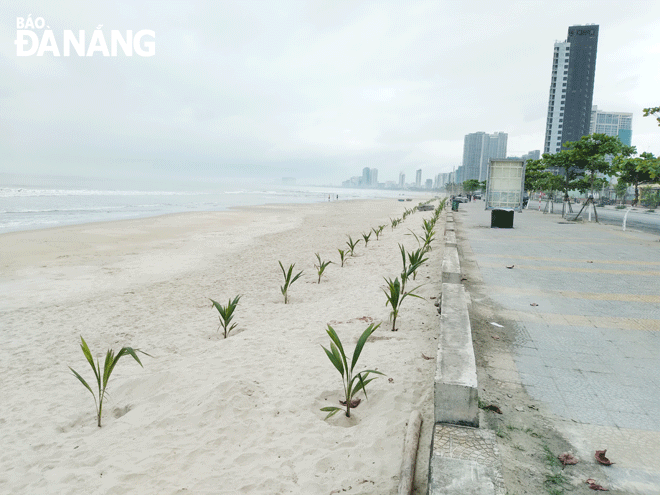Da Nang develops solutions to coastal protection
Strong winds and high waves from storms along with the northeast monsoon have a bigger impact on the coastal erosion in Da Nang. Data released by the Son Tra Marine Observation Station show that the city’s average sea level has risen by 2.55mm per year over the past 20 years.
 |
| Planting trees is one of the city’s solutions to manage coastal erosion. IN THE PHOTO: Two rows of dwarf coconut trees were planted by members of the municipal Farmers' Association on the Man Thai Beach in Son Tra District on February 11, 2022 in a bid to prevent shoreline erosion. Photo: HOANG HIEP |
Effective policy responses to the effects of climate change on Da Nang’s coastal areas require comprehensive long-term mitigation and adaptation strategies with both hard and soft adaptation measures. Two rows of coconut trees planted along a beach and located about 50 meters north of the Muong Thanh Luxury Danang Hotel in Son Tra District were still standing after Super Typhoon Rai affected Da Nang on December 19 and 20, 2021. However, since late December 2021, the northeast monsoon has caused deep penetration of ocean waves into shore, leading to the disappearance of these coconut trees and the collapse of about 2m of beach sidewalks. My An and My Khe beaches are the worst-affected areas in Da Nang during the rainy season in 2021. Since the beginning of 2022, coconut trees planted on the sandbank have been damaged during the northeastern monsoon.
Mr Vo Tien Dung, the Director of the Da Nang Management Board for Agriculture and Rural Development Projects, said that the municipal government has directed the Management Board of Son Tra peninsula and Da Nang tourist beaches to repair beach erosion along the eastern coastline in order to ensure the safety of beach-goers. The Da Nang Management Board for Agriculture and Rural Development Projects was tasked to create embankments along coastal areas and repair the damaged works in efforts to mitigate shore erosion.
Members of the Da Nang Farmers' Association on February 11, 2022 planted two rows of dwarf coconut trees which can grow to heights of 1.2 to 1.5 metres within 1km of the shoreline on the Man Thai Beach in Son Tra District to protect the sandy beach and prevent coastal erosion. Besides, members of Man Thai Ward Chapter of the municipal Farmers' Association have been active in caring for these young trees until they're mature enough to thrive on their own.
Mr Nguyen Huu Thiet, the Chairman of the municipal Farmers' Association stated that tall coconut trees planted on the beach are usually washed away with the waves as their roots are slow to move into sand. Meanwhile, dwarf coconut trees will firmly rooted in the sand 6 months after planting, and these trees will start to produce fruit 3 years after planting. The Association will continue to plant these trees on a part of the coastal area in Ngu Hanh Son District as well as find more trees that are capable of withstanding and surviving drought and salt events in a bid to guide farmers on production of such plants.
Mr Phan The Dung, the Director of the municipal Forest Protection Department under the municipal Department of Agriculture and Rural Development, said that the forestry sector is planning to develop 362 ha coastal protection forests, and its plan will be annually carried out in Da Nang in the months of October, November and December.
According to the Da Nang Department of Agriculture and Rural Development, the entire coastline of Da Nang and its coastal infrastructure, including Da Nang Bay and coastal areas along Hoang Sa, Vo Nguyen Giap and Truong Sa routes are at risk from erosion and landslides. In which, beaches along Hoang Sa, Vo Nguyen Giap and Truong Sa routes, especially the parts from Pham Van Dong Street to Ngo Thi Sy Street are highest risk areas for erosion and landslides.
The Da Nang government approved a plan to deal with coastal erosion on November 1, 2021. From now until 2025, the city will build new embankments with a total length of 1,255m to protect its coastal areas from erosion. In particular, embankments will be created at two heavily-damaged sections of the city’s coastline with a total length of 585m: one from Vo Van Kiet to Nguyen Van Thoai, and the other from Nguyen Van Thoai to Do Ba.
Mr To Van Hung, the Director of the municipal Department of Natural Resources and Environment said that global climate change poses serious threats of sea level rise and coastal erosion to Da Nang. Therefore, Da Nang is developing its effective approaches to better respond to climate change in parallel with making adjustments to the Master Plan for the development of Da Nang to 2030 with a vision to 2045.
Reporting by HOANG HIEP – translating by H.L